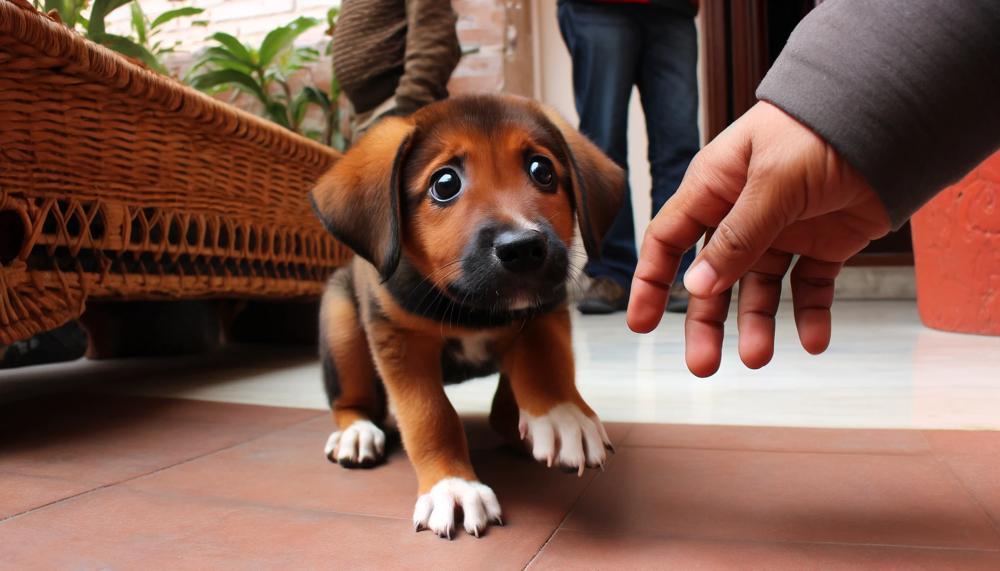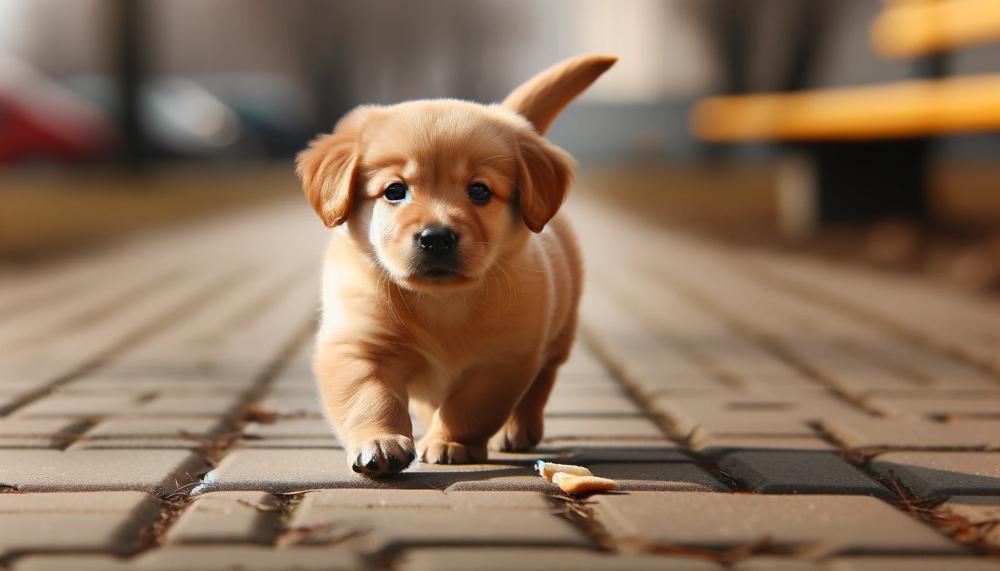Imagine this: you’ve just welcomed a precious, fluffy puppy into your home and you’re excited to take them on their first walk through the neighborhood. But as soon as you attach their leash and open the front door, your pup freezes in terror, tail tucked between their legs. What could be causing this fear? Why do puppies sometimes dread going on walks?
Puppies can be scared to go on walks for several reasons:
- Unfamiliarity with the leash and collar: The leash is a form of restraint and can be intimidating for a puppy. They might not be able to go where they want or escape from anything that frightens them.
- Negative experiences: If a puppy has had negative experiences involving strangers, other pets, or loud noises while on a walk, they might associate walking with these experiences and become anxious.
- Overstimulation: The outdoors can be overwhelming for a puppy with all the sights, sounds, and smells.
- Lack of socialization: Puppies who haven’t been exposed to a variety of people, dogs, and environments might be fearful.
In this blog post, we’ll delve into the reasons behind puppies’ fear of walks and provide valuable tips for helping them overcome their anxieties.
Whether you’re a new puppy parent or simply curious about canine behavior, keep reading to gain insight into this common issue.
Why Is Puppy Scared To Go On Walks?
Table of Contents
- 1 Why Is Puppy Scared To Go On Walks?
- 2 The Impact of Negative Experiences on a Puppy’s Behavior
- 3 Signs and Symptoms of a Scared Puppy
- 4 How to Help Your Puppy Overcome Its Fear of Walks
- 5 Choosing the Right Leash for Walking a Nervous Puppy
- 6 Finding the Perfect Route for Your Scared Puppy
- 7 Using Treats as Incentives for Walking with Your Puppy
- 8 Conclusion
| Why Is Puppy Scared To Go On Walks? | Description |
| Inadequate Socialization | A puppy’s lack of exposure to new environments, unfamiliar people, and other animals may cause fear and distress during walks. |
| Sound Sensitivity | Puppies with sensitive hearing may be easily startled by loud or sudden noises while on walks, causing them to feel anxious and scared. |
| Change of Scenery Factors | A sudden change in scenery, such as walking in a new neighborhood, can be unsettling for a puppy and trigger fear and anxiety. |
| Inexperience with Leash Walking | Puppies who have not been properly leash trained may feel uneasy or uncomfortable when first introduced to the concept of walking on a leash. |
| Unpleasant Experiences in the Past | If a puppy has had negative experiences while on walks in the past, they may develop a fear or aversion to going on walks in the future. |
| Puppy Inexperience | Youthful puppies with little exposure to the outdoors or leash walking may feel scared or overwhelmed when first venturing outside. |
| Fear of Thunderstorms | Puppies who are afraid of loud noises, such as thunderstorms, may also become fearful during walks if they are exposed to similar sounds. |
| Illness or Pain | If a puppy is feeling unwell or experiencing pain, they may not want to go on walks and will exhibit fear or avoidance behaviors. |
| Disinterest | Some puppies may simply not be interested in going on walks and would rather stay inside or engage in other activities that they find more enjoyable. |
Puppies are naturally curious and adventurous creatures, but some may be hesitant to go on walks due to various factors. It is important for dog owners to understand these reasons in order to help their puppy overcome its fear and enjoy going on walks.
The Impact of Negative Experiences on a Puppy’s Behavior
Bad things that happen to puppies when they are young can have a big effect on how they act, especially when they go for walks. These bad experiences can be anything from not having enough friends to being a stressed-out mom. They can cause fear, anxiety, and other behavior problems that may show up on walks.
Here, we’ll talk about how bad experiences can affect puppies and give dog owners ways to help their pet friends get over these problems so they can enjoy walks.
| Negative Experiences | Impact on Puppy’s Behavior | Tips for Dog Owners |
| Inadequate Socialization | Can lead to fear and anxiety towards unfamiliar people, dogs, and environments, making walks a stressful experience for puppies. | – Gradually expose your puppy to various people, objects, and environments in a positive and gentle manner. – Use treats and praise to create positive associations with new experiences. – Seek guidance from a professional trainer for proper socialization techniques. |
| Maternal Stress | Can cause hormonal imbalances in the mother, leading to behavioral issues in her puppies. | – Ensure the mother receives proper care and nutrition during pregnancy. – Provide a calm and stress-free environment for the mother during pregnancy. – Consider early neurological stimulation (ENS) for the puppies to potentially improve outcomes. |
| Past Negative Experiences | Puppies who have experienced traumatic events, such as abuse or neglect, may exhibit fear or aggression during walks. | – Be patient and understanding with your puppy. – Seek professional help if necessary to address any underlying behavioral issues. – Use positive reinforcement techniques to build trust and confidence in your puppy. |
It’s important to remember that every dog is different and may react to bad things in different ways. Some may show signs of fear or anger right away, while others may do things that are more subtle and go ignored. As a responsible dog owner, you must closely monitor your puppy’s behavior and promptly address any issues.
Signs and Symptoms of a Scared Puppy
Puppies, just like humans, can experience feelings of fear and anxiety. As a responsible dog owner, it is crucial to be able to recognize the signs and symptoms of a scared puppy. These signs can include:
- Excessively panting: When a puppy is scared, they may start panting more than usual. This could be a sign of stress or discomfort.
- Drooling excessively: Similar to panting, excessive drooling can also be a sign of stress and anxiety in puppies.
- Dilated pupils: When a puppy is feeling scared or anxious, their pupils may become enlarged as their body prepares for potential danger.
- Shivering or trembling: Just like humans, puppies may start shivering or trembling when they are scared or anxious.
- Accidents indoors: Fear and anxiety can cause puppies to lose control of their bladder or bowels, leading to accidents inside the house.
- Low body posture with head down: It is common for puppies to keep their body low and head down as a submissive behavior, which could indicate that they are feeling scared or intimidated.
- Ears tucked back: Puppies may tuck their ears back against their head as a way to protect themselves when they are feeling scared.
- Tail tucked underneath their body: Along with tucking their ears back, puppies may also tuck their tail underneath their body when they are feeling scared or anxious.
As a pet parent, it is important to pay attention to these signs and symptoms in order to address the underlying cause of fear and anxiety in your puppy. By providing a safe and nurturing environment and using proper training techniques, you can help your puppy overcome fear and enjoy walks as a positive and enriching experience.
How to Help Your Puppy Overcome Its Fear of Walks
| Step 1: Understand the root cause of the fear | Determine the reason behind your puppy’s fear of walks, such as past traumatic experiences or a lack of socialization. |
| Step 2: Gradually introduce walks | Start with short walks and slowly increase the distance to build confidence and reduce fear. Varying the route and using a safe retractable leash can also help. |
| Step 3: Use positive reinforcement | Reward your puppy with treats, praise, and affection to create positive associations with going outside. |
| Step 4: Desensitization and counterconditioning | Introduce your puppy to the feared stimuli in a controlled manner while simultaneously providing something positive, such as treats or playtime. |
| Step 5: Seek professional help | If your puppy’s fear is severe, consult a certified trainer or behaviorist for personalized training plans. |
| Step 6: Create a safe and comfortable environment | Provide a designated retreat spot and calming tools for your puppy at home, such as a cozy bed or calming music. |
| Step 7: Be patient and consistent | Overcoming fear takes time, so remain patient and consistent in your efforts. Remember to always use positive reinforcement and avoid punishing your puppy for their fear. |
| Anecdote: | I once had a puppy who was terrified of walks due to a previous traumatic experience. To help her overcome her fear, I started taking her on short walks with lots of treats and praise. I also made sure to choose quiet and familiar routes and gradually increased the distance. Now, she loves going on walks and even leads the way most of the time. |
In addition to these practical steps, it is crucial to be patient and consistent in your efforts. It may take time for your puppy to overcome their fear, but with positive reinforcement and a safe environment, they can learn to enjoy walks.
Choosing the Right Leash for Walking a Nervous Puppy
When it comes to finding the perfect leash for a nervous puppy, there are several key factors that you should take into consideration. These include the type of leash, the material it is made of, its length, the comfort of the handle, reflective properties, training purposes, flexibility, and your own comfort level.

For a nervous puppy, it is recommended to opt for a standard leash that is 4-6 feet long and made from a lightweight and comfortable material such as nylon or leather. This will ensure that your puppy feels safe and secure while on walks.
Additionally, if you plan on walking your puppy during times of low visibility, it is important to choose a leash with reflective properties for added safety. A training leash may also be useful in gradually introducing your puppy to longer walks and helping with control.
And lastly, don’t forget to consider your own comfort level when selecting a leash as it can greatly impact your ability to control and comfort your nervous puppy.
Finding the Perfect Route for Your Scared Puppy
If you have a scared puppy, you know how challenging it can be to get them comfortable with the outside world.
However, there are ways to gradually introduce them to their fears and make it a positive experience. One of the best methods is finding a suitable walking route for them.
Identifying the Source of Fear:
First and foremost, it’s crucial to identify the source of your puppy’s fear. Is it a particular noise or object that triggers their anxiety? Or is it a past traumatic experience that has left them fearful? Once you understand the root cause, you can work on addressing it and helping them overcome their fears.
Positive Reinforcement:
To help your puppy feel more at ease, use positive reinforcement techniques. Reward them with treats and praise when they exhibit calm behavior in the face of their fears. This will help them associate these situations with positive experiences, making them more likely to feel comfortable in the future.
Finding the Perfect Walking Route:
One of the most effective ways to help a scared puppy is by finding a suitable walking route for them. This could mean avoiding busy streets or areas with loud noises. It may also involve taking shorter walks and gradually increasing the distance as they become more comfortable.
Be patient and understanding throughout this process, and remember that seeking professional help may also be beneficial.
So, helping your scared puppy requires patience and understanding. By gradually introducing them to their fears, providing positive reinforcement, and finding the perfect route for walks, you can help them overcome their anxieties and enjoy the outside world with confidence.
Using Treats as Incentives for Walking with Your Puppy
Using treats as rewards is an incredibly effective technique to help your puppy conquer their fear of taking walks. Here are some specific ways to incorporate treats into this process:
- Begin small and gradually increase the level of difficulty. Start by giving your puppy a treat every time you take them outside for a walk, even if it’s only for a few steps.
- Opt for high-value treats that your puppy adores, such as small bits of chicken or cheese.
- Offer treats at specific milestones along the way, such as when they reach the end of the block or successfully walk past a loud noise without getting scared.
- Remember to give treats immediately after the desired behavior to reinforce it.
- Stay consistent in using treats as incentives and always have them readily available during walks.
- Keep in mind that each puppy is unique and may respond differently to treats as rewards.
Conclusion
There are several reasons a puppy might not want to go for walks: not enough training, bad experiences in the past, and natural instincts to stay safe.
To avoid future problems, pet owners must know these reasons and take care of them right away.
Progressively adding walks to your puppy’s schedule, using positive reinforcement, finding a good route, and getting the right tools, like leashes and treats, can help your furry friend get over their fears and enjoy walks as a fun and educational activity.
Remember to be patient and consistent with your approach, get help from a professional if you need to, and always put your puppy’s safety and comfort first.






